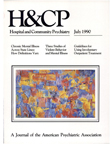Violence and Psychiatric Disorder in the Community: Evidence From the Epidemiologic Catchment Area Surveys
Abstract
Data from the Epidemiologic Catchment Area survey were used to examine the relationship between violence and psychiatric disorders among adults living in the community. Psychiatric assessment of survey respondents was based on the Diagnostic Interview Schedule, which also provided self-report information about violent behavior. Those who reported violent behavior within the preceding year tended to be young, male, and of low socioeconomic status, and more than half met DSM-III criteria for one or more psychiatric disorders. Subjects with alcohol or drug use disorders were more than twice as likely as those with schizophrenia to report violent behavior. In a multivariate model of the predictors of violence, a significant interaction effect was found between major mental illness and substance abuse. The risk of violent behavior increased with the number of psychiatric diagnoses for which respondents met DSM-III criteria.
Access content
To read the fulltext, please use one of the options below to sign in or purchase access.- Personal login
- Institutional Login
- Sign in via OpenAthens
- Register for access
-
Please login/register if you wish to pair your device and check access availability.
Not a subscriber?
PsychiatryOnline subscription options offer access to the DSM-5 library, books, journals, CME, and patient resources. This all-in-one virtual library provides psychiatrists and mental health professionals with key resources for diagnosis, treatment, research, and professional development.
Need more help? PsychiatryOnline Customer Service may be reached by emailing [email protected] or by calling 800-368-5777 (in the U.S.) or 703-907-7322 (outside the U.S.).



